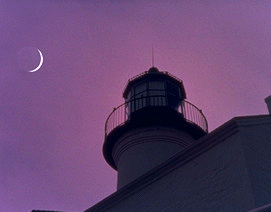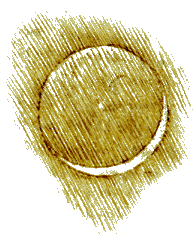
|
|||||||||||
|
|
|||||||||||
|
|
|
Earthshine
Meanwhile, we can enjoy Earthshine from our own planet. Perhaps the sight is less dazzling than a Full Earth seen from the Moon. Yet, as my near-accident proves, it has an arresting beauty all its own. Indeed, this month and the next may be the best time to see it. Scientists in recent years have studied the Moon's ashen glow to discover how much sunlight our planet reflects -- a key datum for global warming studies. They've found that Earthshine is most intense -- about 10% brighter than average -- during April and May. Phil Goode of Big Bear Solar Observatory is principal investigator of Project Earthshine, a NASA-supported effort to monitor Earth's albedo (the astronomer's term for reflectivity). He says, "it's not surprising that Earth's albedo changes with the seasons." After all, most of the sunlight reflected from our planet is reflected from clouds -- and cloud cover changes from one season to the next. Clouds dominate the "shininess" of our planet, adds Goode. "They reflect about 50% of the sunlight that hits them -- more than oceans (10%) or land (10% to 25%). Only snow and ice reflect more (40% to 90%) than clouds do, but snowy areas tend to be cloud covered anyway." Although the spring peak wasn't surprising to Goode, its size was. The extra Earthshine in April and May was about twice as much as computer models predicted based on actual satellite observations of ice and cloud cover. It's a lingering mystery. There are faster changes, too: As our planet rotates, different parts of it turn to face the Moon. To a lunar astronaut, the Pacific Ocean would appear relatively dark -- like a maria on the Moon itself. On the other hand, a big cloud-covered continent like Asia could reflect two or three times more sunlight than Pacific waters. For this reason the Moon's ashen glow can wax and wane from hour to hour -- "at the 5% level," says Goode. Did you see Earthshine during the weekend of April 12-14?. The Moon was New April 12, which means that the Earth was Full and shining brightly down on lunar terrain. "The Sun's glare makes it impossible to see a New Moon (except during a solar eclipse)," says University of Florida astronomy professor George Lebo, "so we had to wait until Sunday and Monday when the Moon had moved a little bit away from the Sun." On Sunday evening, April 14, just after local sunset, the Moon appeared as a very thin crescent hanging low on the western horizon. "We call this a 2-day old Moon," says Lebo, "because it is two days past New." It should be a spectacular sight. Not only will the Moon's crescent be amazingly thin -- and the Earthshine bright -- but also brilliant Venus will lie a mere 5 degrees away (just as it was when I nearly wrecked my truck). "The best time to look should be between 7:30 and 8:00 p.m. local time," says Lebo. "An unobstructed view of the horizon is essential." On Monday evening, April 15, the three-day old Moon will lie farther from the Sun and so the sky behind it will be darker than the night before. The Moon should be easy to find about 30 degrees above the western horizon at 8 p.m. local time. Says astronomer Clay Sherrod: "I tell my students that such a crescent Moon is best for spotting Earthshine -- provided that the sky is clear and transparent." That bright star beside the Moon on Monday night will be the planet Mars. By Tuesday, April 16, the Earthshine will begin to fade: it will be hard to see against the glare of the growing sunlit portion of the Moon. Plus, Earth -- which has phases on the Moon just as the Moon has phases on Earth -- will no longer be so "Full" in lunar skies. Sunday and Monday are the evenings to watch. Just don't gawk and drive. This article was written by MAGS member, Mike Baldwin ©2006. Information in this article used for educational purposes under the provisions of the Fair Use Act of 1976.
Credits & Contacts
|
|||||||||
|
|
|||||||||||


